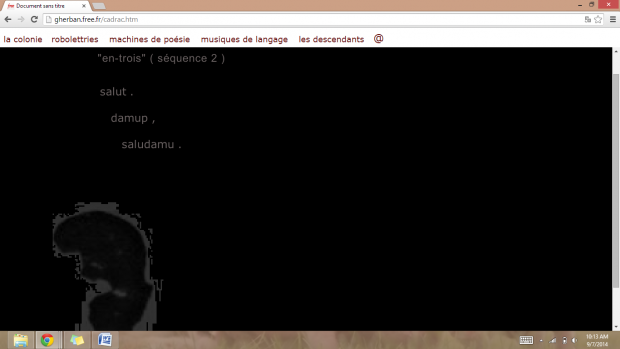Trois machines de poésie
Les Trois Machines de Poésie by Alexandre Gherban are three poetry generators that use text entered by the reader. Gherban’s program is dynamic, meaning that the text changes with every new reading. The program is at times transitory, at others not. The interesting thing is that the program offers an impersonal perspective, which makes the reader feel like an observer rather than a participant; but at the same time, the necessity for the reader to click at times and enter text makes the reader an explicit participant in the story of the creation of the poetry. The machine asks the reader for a series of text that will be controlled, and yet the only times the reader truly has control over the work is this same textonic aspect, the reader’s textual entry, and the reader’s transitory responsibilities. The third machine also gives the reader a choice. After having entered the mandatory text, the reader must also choose the “two parents” who “will create 901 nursery rhymes by playing with your text, a few of which you will read.” The reader has more power in this moment than in all the rest of the work, but the machine also gives the reader a sense of lack of control by declaring that we will only see “a few” of the entire work. The limited access to the different parts of the poem that play out underlines this sense of lack of control.
According to Alexandre Gherban, “the author creates a program but the reader or the spectator interacts with an observable process that escapes all desires.” Gherban believes that the capacity of computers to manifest a work of art in the present moment is a new form of art. According to Gherban, the instantaneous moment is essential for these works of art because it allows us to see that the interaction between humans and machines is the most important concept for poetry. Every time a new reader approaches Gherban’s poetry machines, new letterist poems are created. The second machine declares that it will create a “self portrait” in real time. Here we see the aesthetic of artificial life: a shape enlarges on the screen after each sequence before asking the reader for more textual input. This shape is the manifestation of a visual self portrait and represents the poem that is being created in that instant. Like in the third machine, the two parents, the machine and the reader, create their descendant, the poem.
(Source: Alexandra Martin)
Les Trois Machines de Poésie d’Alexandre Gherban sont trois générateurs de poésie qui utilise du texte entré par le lecteur. C’est un programme dynamique, c’est-à-dire le texte change à chaque reprise. Le programme est des fois transitoire, d’autres fois non-transitoire. Ce qui est intéressant c’est que le programme offre une perspective impersonnelle, ce qui fait que le lecteur se sent comme observateur et non comme un participant ; mais à la fois le chaînage explicite et la fonction d’entrée de données rendent le lecteur explicitement participant à l’intrigue de la création de cette poésie. On demande au spectateur une série d’entrées contrôlées ; mais les seules fois où le spectateur a un contrôle sur l’œuvre c’est l’aspect textonique, ou l’entrée de données du lecteur, et des fois l’aspect transitoire quand il faut faire cliquer sur un symbole pour faire continuer la poésie. La troisième machine donne aussi au spectateur aussi un choix. Après avoir créé le texte le spectateur doit aussi choisir les « deux parents » qui « feront en jouant avec votre texte, 901 comptines dont vous lirez quelques unes. » À ce moment-là, le spectateur a le plus de pouvoir qu’il en a eu dans l’ensemble des trois œuvres, mais la machine donne au spectateur une impression de déprise en déclarant qu’on ne verra jamais toute l’œuvre, sauf « quelques unes. » L’accès contraint souligne cette sensation de déprise chez le lecteur.
Selon Alexandre Gherban « L’auteur crée un programme mais le lecteur ou le spectateur interagit avec un processus observable qui échappe aux volontés ». Gherban pense que la capacité des ordinateurs à manifester une œuvre au présent est une nouvelle forme d’art. Chez Gherban, l’instant est le plus important dans ces œuvres, alors on voit que l’interaction entre l’humain et la machine est l’aspect le concept le plus important pour la poésie. Chaque fois qu’un nouveau spectateur approche les machines de Gherban, il crée des nouveaux poèmes lettristes. La deuxième machine déclare qu’elle crée « un autoportrait » en temps réel. Voilà l’esthétique de la vie artificielle : une forme grandît sur l’écran à la fin de chaque séquence avant de demander au spectateur du nouveau texte. Cette forme et la manifestation d’un autoportrait visuel et représente le poème qui est en création dans l’instant. Comme dans la troisième machine, les deux parents, ici la machine et le spectateur, créent leur descendant, le poème.
(Source: Alexandra Martin)


